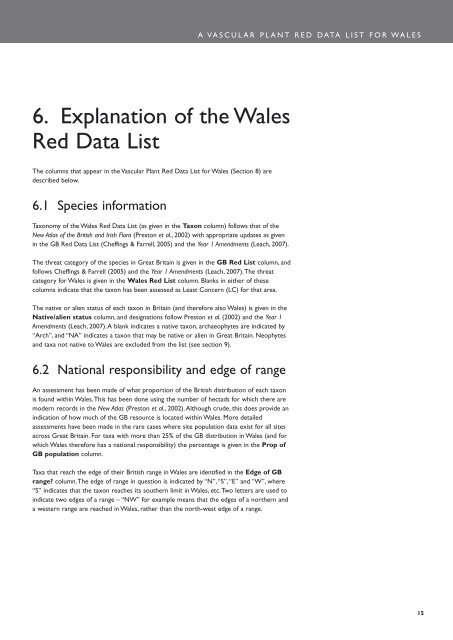A Vascular Plant Red Data List for Wales - Plantlife
A Vascular Plant Red Data List for Wales - Plantlife
A Vascular Plant Red Data List for Wales - Plantlife
You also want an ePaper? Increase the reach of your titles
YUMPU automatically turns print PDFs into web optimized ePapers that Google loves.
A VA S C U L A R P L A N T R E D D ATA L I S T F O R WA L E S6. Explanation of the <strong>Wales</strong><strong>Red</strong> <strong>Data</strong> <strong>List</strong>The columns that appear in the <strong>Vascular</strong> <strong>Plant</strong> <strong>Red</strong> <strong>Data</strong> <strong>List</strong> <strong>for</strong> <strong>Wales</strong> (Section 8) aredescribed below.6.1 Species in<strong>for</strong>mationTaxonomy of the <strong>Wales</strong> <strong>Red</strong> <strong>Data</strong> <strong>List</strong> (as given in the Taxon column) follows that of theNew Atlas of the British and Irish Flora (Preston et al., 2002) with appropriate updates as givenin the GB <strong>Red</strong> <strong>Data</strong> <strong>List</strong> (Cheffings & Farrell, 2005) and the Year 1 Amendments (Leach, 2007).The threat category of the species in Great Britain is given in the GB <strong>Red</strong> <strong>List</strong> column, andfollows Cheffings & Farrell (2005) and the Year 1 Amendments (Leach, 2007).The threatcategory <strong>for</strong> <strong>Wales</strong> is given in the <strong>Wales</strong> <strong>Red</strong> <strong>List</strong> column. Blanks in either of thesecolumns indicate that the taxon has been assessed as Least Concern (LC) <strong>for</strong> that area.The native or alien status of each taxon in Britain (and there<strong>for</strong>e also <strong>Wales</strong>) is given in theNative/alien status column, and designations follow Preston et al. (2002) and the Year 1Amendments (Leach, 2007).A blank indicates a native taxon, archaeophytes are indicated by“Arch”, and “NA” indicates a taxon that may be native or alien in Great Britain. Neophytesand taxa not native to <strong>Wales</strong> are excluded from the list (see section 9).6.2 National responsibility and edge of rangeAn assessment has been made of what proportion of the British distribution of each taxonis found within <strong>Wales</strong>.This has been done using the number of hectads <strong>for</strong> which there aremodern records in the New Atlas (Preston et al., 2002).Although crude, this does provide anindication of how much of the GB resource is located within <strong>Wales</strong>. More detailedassessments have been made in the rare cases where site population data exist <strong>for</strong> all sitesacross Great Britain. For taxa with more than 25% of the GB distribution in <strong>Wales</strong> (and <strong>for</strong>which <strong>Wales</strong> there<strong>for</strong>e has a national responsibility) the percentage is given in the Prop ofGB population column.Taxa that reach the edge of their British range in <strong>Wales</strong> are identified in the Edge of GBrange? column.The edge of range in question is indicated by “N”,“S”,“E” and “W”, where“S” indicates that the taxon reaches its southern limit in <strong>Wales</strong>, etc.Two letters are used toindicate two edges of a range – “NW” <strong>for</strong> example means that the edges of a northern anda western range are reached in <strong>Wales</strong>, rather than the north-west edge of a range.15
















